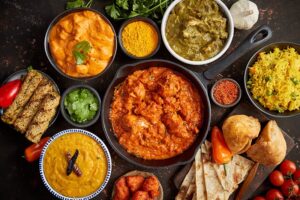South Asian folk art stands as a vibrant reflection of the diverse cultures, traditions, and histories found across the Indian subcontinent. From the remote tribal villages of India and Pakistan to the bustling urban landscapes of today, the evolution of this art form speaks to its enduring appeal and timelessness. Rooted in rituals, storytelling, and spirituality, South Asian folk art has transcended its tribal origins to become an integral part of modern art, culture, and cuisine. This evolution is a testament to the adaptability and resilience of traditional art in a rapidly changing world.
Tribal Beginnings: The Roots of South Asian Folk Art
The origins of South Asian folk art can be traced back thousands of years to rural, often isolated, communities that used art as a means of communication and cultural expression. Each tribal community developed its own distinctive style, reflecting the surrounding environment, social structure, and spiritual beliefs. In regions like Rajasthan and Gujarat, rural communities would paint murals on the walls of their homes or craft intricate designs on pottery, textiles, and everyday objects.
In India, the Bhimbetka rock shelters, a UNESCO World Heritage site, contain cave paintings that date back more than 30,000 years. These ancient depictions of animals, human figures, and daily activities are among the earliest examples of tribal folk art. Similarly, in Pakistan, the Thar Desert’s Sindhi communities have long been known for their vibrant textile traditions, including Ajrak and Ralli quilts, which are made using intricate block printing and embroidery techniques.
These early forms of folk art were not merely decorative but held deep cultural significance. They were integral to rituals, festivals, and social ceremonies. Art often had a spiritual dimension, acting as a means of connecting with the divine or commemorating important life events such as marriages and births. The motifs, patterns, and symbols used in these artworks carried meanings passed down through generations, forming a visual language understood within the community.

The Transition: Folk Art in Historical Context
While tribal communities remained largely isolated, the Mughal and British colonial periods introduced new influences and opportunities for South Asian folk art to evolve. During the Mughal era, India and Pakistan witnessed a flourishing of artistic expression, with folk art blending with the refined, Persian-influenced art of the royal courts. Mughal rulers, patrons of the arts, encouraged the creation of detailed miniature paintings, which often incorporated themes from local folk traditions.
During British colonization, folk art played a key role in preserving cultural identity. As Western influences pervaded many aspects of life, rural communities clung to their artistic heritage as a means of resistance and self-expression. This period also saw an increase in trade, which helped spread South Asian folk art beyond local communities. Textiles, paintings, and handicrafts began to reach international markets, bringing global attention to the artistry of the region.
The introduction of new materials and techniques during this time further transformed traditional folk art. Artists began experimenting with modern tools and mediums, blending old and new styles. This era marked a transition in folk art’s evolution, as it slowly moved from being a purely local, tribal craft to a more widely recognized and celebrated art form.
Tracing the Roots of Pakistani Truck
Popular South Asian Folk Art Styles
South Asian folk art is incredibly diverse, with each region contributing its own unique techniques, materials, and motifs. Some of the most renowned folk art styles include:
Madhubani Paintings
Madhubani art originated in the Mithila region of Bihar, India. Traditionally created by women, these paintings are characterized by vibrant colors and intricate patterns, often depicting nature, mythology, and daily life. Originally painted on walls and floors during festivals, Madhubani has now become popular on canvases, cloth, and paper.
Warli Art
The Warli tribe of Maharashtra, India, developed a minimalist style of folk art that uses simple geometric shapes—circles, triangles, and squares—to depict scenes from village life. Warli art is traditionally painted on the walls of mud houses using rice paste and is known for its use of earthy tones and depictions of everyday rural activities.
Ajrak Art
Ajrak is a traditional block-printing technique from the Sindh region of Pakistan. This centuries-old textile art involves creating intricate patterns using natural dyes in rich, deep hues of red, blue, and black. Ajrak is often used to make shawls, scarves, and other garments, symbolizing the artistic heritage of the Sindhi people.
Pattachitra
Pattachitra is a style of scroll painting that originated in Odisha, India. The paintings are known for their intricate details, mythological themes, and vibrant colors. Traditionally created on cloth or dried palm leaves, Pattachitra often depicts stories from Hindu epics such as the Mahabharata and Ramayana.
Kalamkari
Kalamkari is a form of hand-painted or block-printed cotton textile that originated in Andhra Pradesh, India. The name “Kalamkari” is derived from “kalam,” meaning pen, and “kari,” meaning craftsmanship. Artists use a bamboo pen to draw freehand designs on fabric, which are then colored with natural dyes.
Truck Art
One of the most distinctive and colorful forms of South Asian folk art, truck art originated in Pakistan as a way for truck drivers to personalize their vehicles. Trucks are adorned with vibrant paintings of animals, landscapes, religious symbols, and calligraphy, transforming these vehicles into moving works of art.
The Connection Between Art and Cuisine
South Asian folk art and traditional cuisine share a deep connection, as both reflect the region’s rich cultural history and diverse influences. The vibrant colors, intricate patterns, and symbolic representations in folk art parallel the diverse ingredients, spices, and cooking techniques used in South Asian cuisine.
In the same way that folk art tells a story through visual mediums, South Asian cuisine tells a story through flavors. A dish like biryani, with its layers of fragrant rice, tender meat, and aromatic spices, is much like a carefully crafted Madhubani painting, where every element plays a crucial role in creating a harmonious whole. Samosas, with their crisp outer layers and flavorful fillings, can be compared to Warli art, simple in appearance yet rich with meaning.
At Usmania Dallas, these culinary traditions come to life with dishes that evoke the essence of South Asian culture. Each plate mirrors the artistic traditions of the subcontinent, whether it’s the intricately spiced Peshawari Gosht or the vibrant colors of a well-prepared chaat. The visual appeal of the dishes themselves, with vibrant chutneys and colorful garnishes, resembles the bold use of color in South Asian folk art. Just as truck art brings life to everyday objects with its bright designs, the food at Usmania brings vibrancy to the dining experience through its careful preparation and presentation.
The Modern Revival: Folk Art in Contemporary Culture
In recent decades, there has been a resurgence of interest in South Asian folk art, both within the subcontinent and globally. This revival can be attributed to several factors, including a growing appreciation for traditional crafts, efforts to preserve cultural heritage, and the global demand for handmade, artisanal products.
Organizations, both governmental and nongovernmental, have played a significant role in promoting and preserving folk art. Craft fairs, exhibitions, and workshops have brought artisans into contact with urban audiences, while international demand for “authentic” and “sustainable” art has given rural artists new markets. Today, South Asian folk art can be found not only in rural homes and local markets but also in luxury boutiques, international galleries, and online stores.
Folk art has also found a place in contemporary design, with its motifs and patterns being adapted for fashion, home décor, and even digital media. Artists and designers often draw on traditional techniques to create modern interpretations of folk art, blending the old with the new. This fusion allows folk art to stay relevant in the modern world, without losing its cultural essence.
Famous Handicrafts of Pakistan
The Timelessness of Folk Art
What makes South Asian folk art “timeless” is its ability to evolve while staying true to its roots. Though its forms and mediums may change, the essence of folk art—the storytelling, symbolism, and connection to community—remains constant. From the tribal villages where it all began to the global stage, South Asian folk art continues to captivate and inspire, bridging the gap between the past and the present.
The fusion of folk art and cuisine at Usmania Dallas embodies this timelessness, where centuries-old artistic traditions are celebrated in a modern context, much like the restaurant’s approach to authentic South Asian flavors. Whether displayed in galleries, worn as fashion, or tasted in the spices of a dish, these art forms remind us of the cultural legacy that continues to influence the world today.









